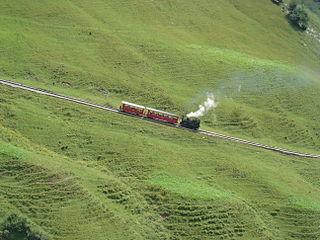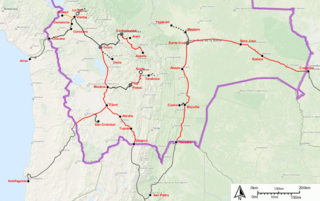
Transport in Chile is mostly by road. The south of the country is not connected to central Chile by road, except through Argentina, and water transport also plays a part there. The railways were historically important in Chile, but now play a relatively small part in the country's transport system. Because of the country's geography and long distances between major cities, aviation is also important.

A mountain railway is a railway that operates in a mountainous region. It may operate through the mountains by following mountain valleys and tunneling beneath mountain passes, or it may climb a mountain to provide transport to and from the summit.

A Garratt is a type of steam locomotive that is articulated into three parts. Its boiler is mounted on the centre frame, and two steam engines are mounted on separate frames, one on each end of the boiler. Articulation permits larger locomotives to negotiate curves and lighter rails that might restrict large rigid-framed locomotives. Many Garratt designs aimed to double the power of the largest conventional locomotives operating on their railways, thus reducing the need for multiple locomotives and crews.

The Trans-Andean railways provide rail transport over the Andes. Several are either planned, built, defunct, or waiting to be restored. They are listed here in order from north to south.

Empresa de los Ferrocarriles del Estado (EFE) is the national railway of Chile.

Rail transport in Peru has a varied history. Peruvian rail transport has never formed a true network, primarily comprising separate lines running inland from the coast and built according to freight need rather than passenger need.

The Ferrocarril de Antofagasta a Bolivia is a private railway operating in the northern provinces of Chile. It is notable in that it was one of the earliest railways built to 2 ft 6 in narrow gauge, with a route that climbed from sea level to over 4,500 m (14,764 ft), while handling goods traffic totaling near 2 million tons per annum. It proved that a railway with such a narrow gauge could do the work of a standard gauge railway, and influenced the construction of other railways such as the Estrada de Ferro Oeste de Minas. It was later converted to 1,000 mmmetre gauge, and still operates today.

The Estrada de Ferro Oeste de Minas (EFOM) was a 2 ft 6 in narrow-gauge railway located in the southeastern Brazilian state of Minas Gerais. At its peak the railway's route totalled 775 km (482 mi). A portion of the railway still operates as a heritage railway, and one of the major stations is now Brazil's largest railway museum.

Bogie exchange is a system for operating railway wagons on two or more gauges to overcome difference in the track gauge. To perform a bogie exchange, a car is converted from one gauge to another by removing the bogies or trucks, and installing a new bogie with differently spaced wheels. It is generally limited to wagons and carriages, though diesel locomotives can be exchanged if enough time is available.

The Buenos Aires Central Railway (FCCBA) was an Argentine railway company which built and operated a 1,435 mmstandard gauge railway line from Buenos Aires to the city of 4 de Febrero in Santa Fe.
Under the Whyte notation for the classification of steam locomotives by wheel arrangement, a 4-4-2+2-4-4 is a Garratt articulated locomotive. The wheel arrangement is effectively two 4-4-2 locomotives operating back to back, with each power unit having four leading wheels on two axles in a leading bogie, four powered and coupled driving wheels on two axles, and two trailing wheels on one axle in a trailing truck. Since the 4-4-2 type is usually known as an Atlantic, the corresponding Garratt type is often referred to as a Double Atlantic.

Ferrosur Roca S.A. (FR) is a private company which operates freight services over part of the 5 ft 6 in broad gauge that belongs to General Roca Railway.

Barsi Light Railway (BLR) was a 202-mile (325 km) long, 2 ft 6 in narrow-gauge railway between Miraj and Latur in the state of Maharashtra in India. It was the brainchild of British engineer Everard Calthrop, and regarded as having revolutionised narrow-gauge railway construction in India.

The Bolivian rail network has had a peculiar development throughout its history; owing to losses of land, prestige and credit rating due to the failure of the War of the Pacific, railway development came late to Bolivia. The demand for mineral wealth and communication to the inland city of La Paz, encouraged foreign investors, mainly British, to construct railways. However, into this mix came the experience of railway building in adjacent Peru, whereby overbuilding of standard gauge line across the high Andes meant that Peru went bankrupt.
The Kaunia–Dharlla State Railway was a 2 ft 6 in narrow gauge railway in a part of British India now in Bangladesh. It was constructed in 1881, and was converted to 1,000 mmmetre gauge in 1901. As a 2 ft 6 in gauge railway it operated small 0-4-2T and 2-4-0T locomotives
The most common track gauge in Chile is the Indian gauge 1,676 mm. In the north there is also some 1,000 mm, metre gauge, rail track.

The DH class was a class of diesel-hydraulic locomotives built by Walkers Limited, Maryborough for Queensland Railways between 1966 and 1974.
Metre and 3 ft gauge lines are found in South America. Some of the 1,000 mm gauge lines cross international borders, though not as efficiently as they might.

750 mm narrow-gauge railways are very similar to 760 mm and 2 ft 6 in gauge. 750 mm gauge rolling stock is almost compatible with 760 and 762 mm railways.















